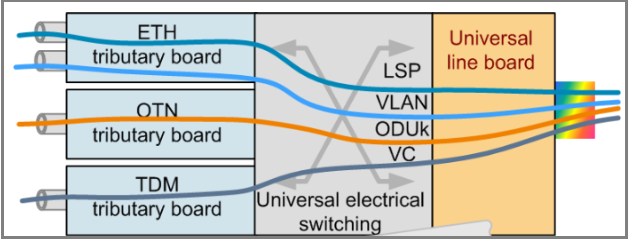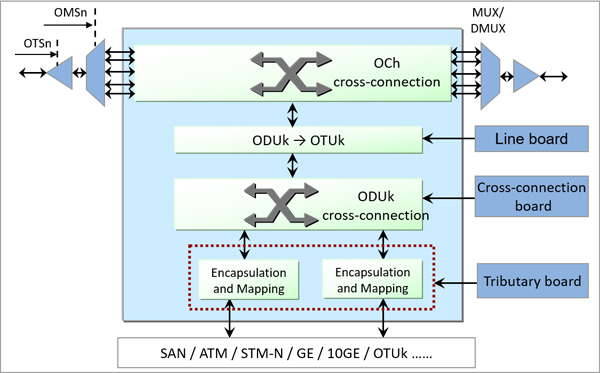
WDM: Wavelength Division Multiplexing
Strictly speaking, WDM refers to a technology that allows optical signals at multiple wavelengths to transmit over one optical fiber.
Typical WDM model:

Based on the number of wavelengths in use, the WDM system can be classified into dense wavelength division multiplexing(DWDM) and coarse wavelength division multiplexing(CWDM).
OTN: Optical Transmission Network
Based on WDM, OTN integrates some advantages of SDH, such as abundant OAM overheads, flexible service grooming, and perfect protection modes.
OTN service grooming is classified into optical-layer grooming and electrical-layer grooming.
Optical-layer grooming can be considered as WDM. And electrical-layer grooming can be understood as SDH.
OTN site model:

The electrical-layer hardware architecture of OTN equipment is the same as that of SDH equipment.: tributary board + cross-connect board + line board

1. The WDM technology applies only to the optical layer and does not apply to the electrical layer. OTN includes both the optical layer and the electrical layer.
2. On a traditional WDM network, one wavelength can transmit only one service. One wavelength on an OTN network can transmit multiple services at the same time.
3. Traditional WDM sites have only OTU boards (wavelength conversion units). In OTN, the OTU board is divided into two parts: tributary board and line board, and electrical cross-connect boards are added. OTU boards can also be directly installed on OTN products.
4. The powerful overhead and monitoring capabilities supported by OTN improve network self-healing protection and reliability. The WDM technology can provide only optical-layer protection. The OTN technology can provide both optical-layer protection and electrical-layer protection.
5. OTN supports more types of services and higher board integration.
6. Through electrical-layer cross-connection grooming, OTN can flexibly schedule and allocate channel resources, improving bandwidth resource utilization.
7. The WDM technology has no corresponding frame structure, whereas the OTN technology has a complete frame structure.
8. OTN sites use a large number of electrical-layer boards. Therefore, network construction costs are high. A WDM site does not have a large number of electrical-layer boards. Therefore, the network construction cost is low.
9. The application scenarios are different. Traditional WDM is mainly applied to the access layer at the edge of the network as an OTM site. An OTN network can provide cross-connections for large-granularity services. The OTN network can be used at the aggregation layer and core layer as OADM sites.